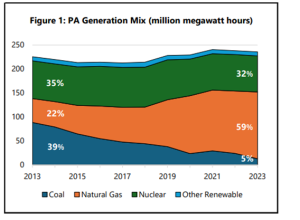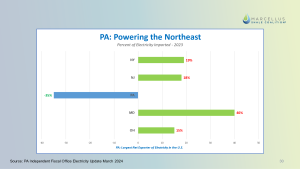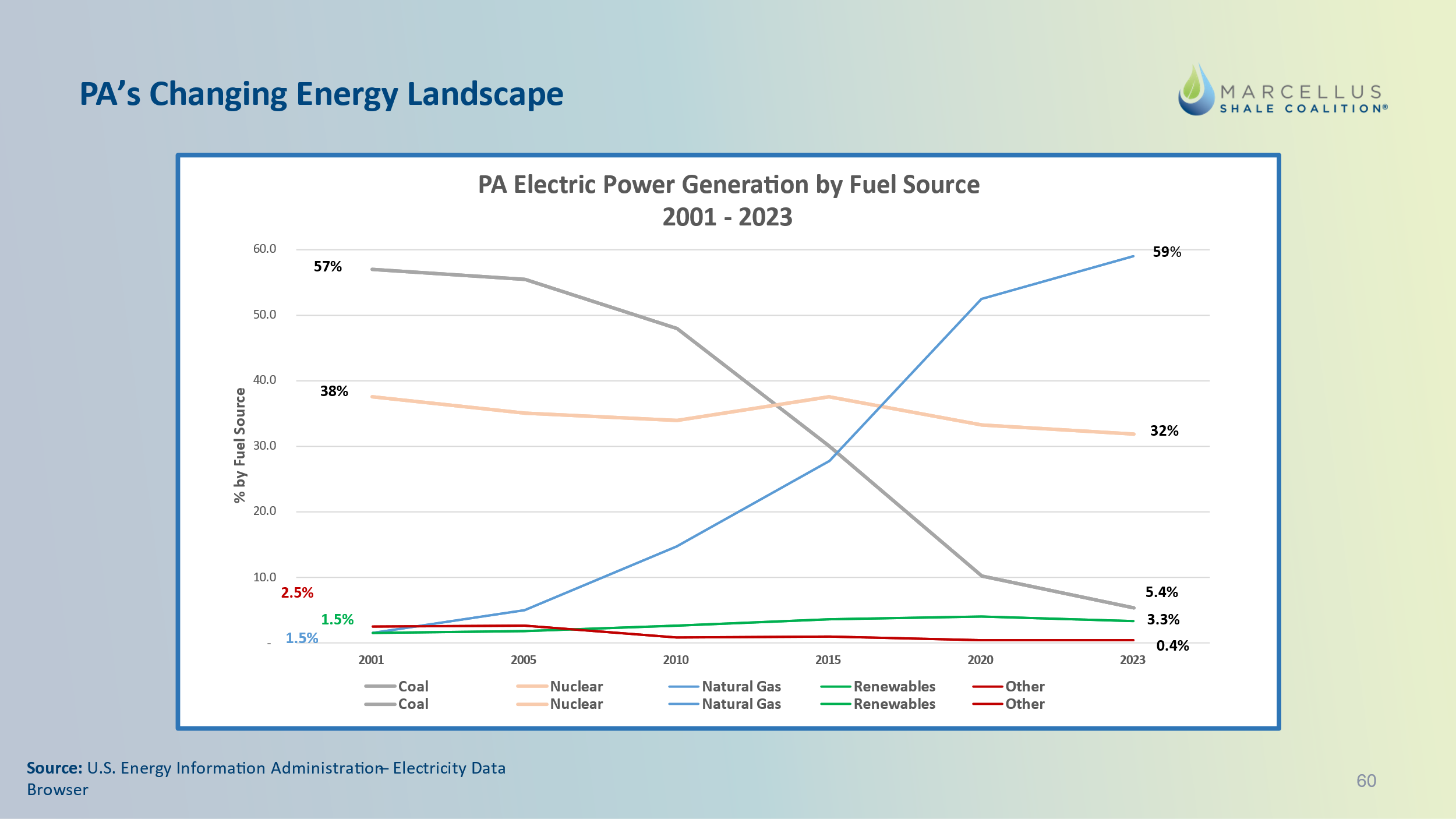Thanks to abundant, clean natural gas, Pennsylvania remained the country’s top electricity exporter while simultaneously reaching a new low for carbon dioxide (CO2) emissions from electricity generation in 2023, according to the Pennsylvania Independent Fiscal Office’s (IFO) latest analysis.
Providing 59% of generation, abundant and reliable natural gas led the sector’s growth while also helping slash CO2 emissions by over 10% in a year, “the largest year-over-year decline for Pennsylvania on record,” IFO states. Not only have overall emissions declined, but from 2018 to 2023, the amount of CO2 emitted per unit of electricity produced declined by 19%.
In fact, natural gas is reducing PA’s power sector emissions at nearly twice the rate of reductions from the pandemic’s stunted economic activity. At the same time, electricity exports from Pennsylvania increased 58% to 83 million megawatt hours (MWh) in 2023 – significantly higher (85%) than Alabama, the number two exporter.
 Pennsylvania and Ohio were the only states to increase generation and reduce related emissions, IFO’s report shows, proving more natural gas use for electric power leads to a more reliable and resilient power grid, accelerates decarbonization and air quality gains, and generates significant cost savings for energy users.
Pennsylvania and Ohio were the only states to increase generation and reduce related emissions, IFO’s report shows, proving more natural gas use for electric power leads to a more reliable and resilient power grid, accelerates decarbonization and air quality gains, and generates significant cost savings for energy users.
For Pennsylvania natural gas consumers, those savings tally up to $5.9 billion compared to where prices were in 2008, PA Public Utility Commission (PA PUC) data shows.
“The Marcellus Shale took us to a place where we needed to be in Pennsylvania…low energy prices,” as former Chair of the PA PUC Gladys Brown Dutrieuille said during MSC’s Natural Gas: Powering Northeast PA briefing. “We’re so happy we’ve moved from a state that was importing electricity to a state that’s now exporting about 30% to other states.”
These exports are fundamental to balancing the power grid and providing the energy that keeps the lights on and saves lives, especially when it’s needed most. Back in January, Pennsylvania’s energy abundance generated an oversupply of electricity, enabling the PJM grid operator to export 10% of power to neighboring regions during Winter Storm Gerri.
Coincidentally, IFO’s data comes amid a nationwide push to phase out natural gas power generation and gas hookups in favor of intermittent and unreliable sources of energy. Short-sighted policies designed to “electrify everything” have led to an underinvestment in natural gas infrastructure and baseload generation and that’s not only exacerbating an already overloaded power grid, it’s increasing costs and even triggering blackouts across the country.
 Thankfully, Pennsylvania has natural gas-fueled electricity generation as its backbone and any reliability challenges there may be here pale in comparison to our neighbors in New England and elsewhere. That said, if we continue to underinvest in natural gas, another recent study warns the Commonwealth could face significant blackouts by 2028.
Thankfully, Pennsylvania has natural gas-fueled electricity generation as its backbone and any reliability challenges there may be here pale in comparison to our neighbors in New England and elsewhere. That said, if we continue to underinvest in natural gas, another recent study warns the Commonwealth could face significant blackouts by 2028.
“Maintaining adequate [electric] resources will be a challenge for the PJM system in the future when the grid is likely to be operating under abnormal conditions,” the Quanta Technology report states, as intermittent renewable resources like wind and solar increase their generation share.
And for what? Not only is natural gas the most affordable and stable fuel source available (with clear climate benefits), it’s also overwhelmingly preferred by U.S. consumers, businesses and restaurants.
Why? “Wind and solar…they just don’t give you a lot of energy,” the Delaware Valley Journal emphasized.
To put it into perspective, baseload power generated from fossil fuels provided more than 80% of the additional electricity that was needed during peak demand from Winter Storm Gerri. In comparison, wind and solar power could only increase its output by 10%.
The undeniable consumer, environmental and energy security gains afforded by Pennsylvania’s natural gas abundance should serve as a wakeup call for those convinced natural gas should not have a rolel in our future energy mix.
“Grid reliability should be the top priority of policymakers in Pennsylvania and throughout the region to ensure citizens, industries, and institutions are not literally left in the dark,” as Pennsylvania Manufacturers’ Association Executive Carl Marra said.





